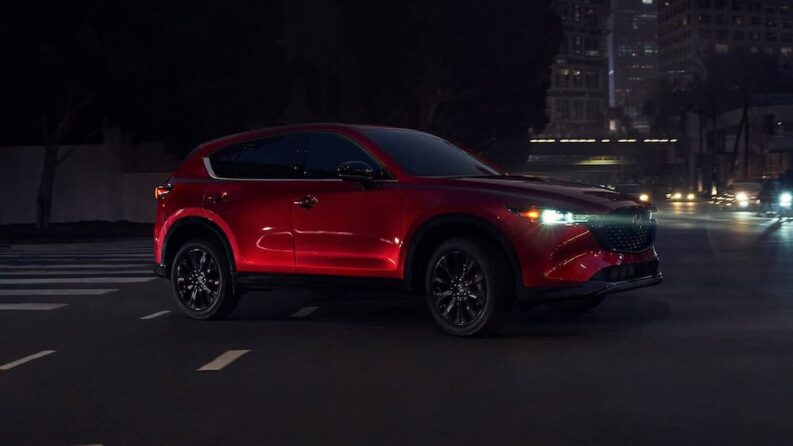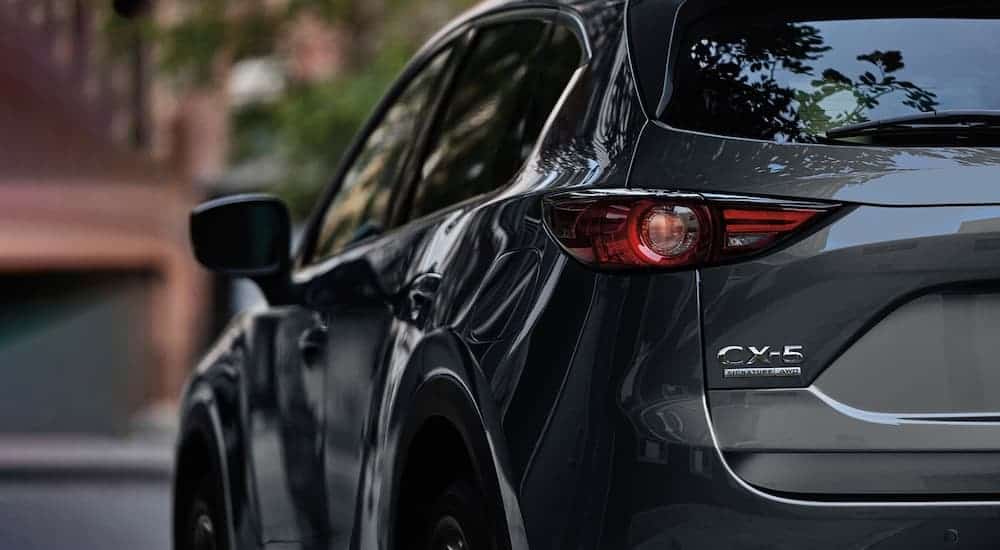The 2023 Mazda CX-5 is a standout for a number of reasons. From responsive handling and a sporty throttle response to an impressive suite of driver-assistance technology and luxury features, this compact crossover punches well above its modest $28,000 sticker price—great news for anyone looking for a Mazda CX-5 for sale. While these features are more than enough to set the CX-5 apart in a crowded segment, it’s the SUV’s bold, unique styling that catches your attention. The interior is exceptionally well-sculpted and packed with premium materials that wouldn’t be out of place on a vehicle that costs twice as much. The CX-5 looks just as good from the outside, with Mazda restyling the SUV in 2022 to bring the decade-old model firmly into the present day. The results speak for themselves, with the CX-5’s thoughtful lines and proportions lending a sense of high-end elegance that’s exceedingly rare in such an affordable vehicle. So rare, in fact, that it got us wondering: how does Mazda manage to consistently strike such a perfect balance between style and affordability?
In a word, Kodo. Roughly translating to “soul of motion,” the design philosophy has been guiding Mazda’s styling approach since 2010. It’s not unusual for a brand to roll out a new slogan to draw some attention, but Kodo is far from being a one-dimensional marketing ploy. It’s a holistic approach to vehicle design that guides every step of the process, from clay models and concept prototypes to road-ready vehicles like the 2023 Mazda CX-5. Read on as we explore Mazda’s design history, delve into the Kodo philosophy, and see how the automaker’s line-up captures the soul of motion.
Inspired By Nature
The Kodo design philosophy was first unveiled to the public with the debut of the Shinari concept car at the 2010 Los Angeles Motor Show. Yet, to truly understand its genesis, we first need to travel back to 2006. Before Kodo, there was Nagare, another automotive design language that Mazda hoped would guide the company’s approach for the years to come.
Created by Laurens van den Acker and Franz von Holzhausen—the latter of whom would go on to design such iconic Tesla models as the Supertruck, Roadster, and Model S—the Nagare design language was informed by the ideas of wind and flow. Nagare-inspired vehicles can be easily distinguished by the sweeping, wave-like lines found on their exterior and their swooping, leaf-shaped headlights. The Nagare concept debuted at the 2006 LA Auto Show in the form of the Mazda Nagare, a long-wheelbase sports car that shared a name with the philosophy itself. Designed with butterfly doors, a wrap-around lounge-style backseat, and a decidedly futurist interior, the Nagare concept model was informed by the dynamics of natural motion, as explained by von Holzhausen. “We began by studying motion and the effect it has on natural surroundings: how wind shapes sand in the desert, how water moves across the ocean floor, and the look of lava flowing down a mountainside. Natural motion registers an impression in your brain, and that’s what we hoped to capture with the new Nagare surface language.”
Mazda continued to experiment with this ambitious design language over the next two years, ultimately rolling out seven concept vehicles that reflected the nature-inspired Nagare approach. The fan-favorite tends to be the Mazda Furai, a race-ready concept based on the Courage C65 LMP2 prototype with a name that literally translates to “wind sound.” The Nagare influence was easy to spot on the Furai, which features stream-like lines across the chassis and grille.
Switching It Up
While the Nagare approach won over many drivers and critics, it was a short-lived experiment in the end, with Mazda abandoning the design language following the release of the Kiyora concept in 2008. The Kiyora was a fitting swan song for the Nagare philosophy as it included the most literal water-inspired element to date: a built-in water filter that converted collected rainwater into drinking water. Mazda’s decision was rooted in practicality. While the Nagare approach had produced some very alluring concept models, the delicate wave- and wind-inspired design elements proved too difficult to scale up to production levels.
Enter Kodo. Conceived by Mazda’s Head of Global Design, Kuo Maeda, Kodo picks up where Nagare left off. Like Nagare, Kodo was inspired by nature but focused less on reflecting the soothing, meandering lines of a stream or wind current. It’s all about potential energy and is more focused on capturing the aggressive, animal-like spirit of a jungle cat getting ready to strike, or a katana held in a battle-ready position. The Kodo philosophy is guided by three keywords—speed, tense, alluring—which, when employed in a balanced manner, create a vehicle that looks poised for action.
“To sum up what we mean by KODO Design, it’s about creating cars that embody the dynamic beauty of life—cars that visually suggest different expressions of this energy,” says Maeda. It’s about imparting a sense of soul and being into animate objects; a tradition solidly rooted in Japanese culture. “In Japan, we feel that craftsmen inject life into what they make, so objects that receive the love and caring attention of these craftsmen have a vital force; a soul. As we are a Japanese car company, we believe that a form sincerely and painstakingly made by human hands gets a soul.”
When the Mazda team went to work on the Shinari concept car in 2010, Maeda didn’t instruct designers to draft a vehicle, but rather, simple objects. Dubbed “exploratory preparation,” this process focused on making designers comfortable with imbuing their creations with a real sense of soul. Examples of this unique R&D approach were on display at Milan Design Week in 2014, where Mazda showcased a chair inspired by the Kodo design language. The brand doubled down on the exhibit the following year, inviting two emerging fashion designers to create outfits based on the concept, which were showcased next to the Mazda MX-5.
Once the team had mastered the Kodo concept, Maeda unleashed them on an actual vehicle, and in time, the Shinari was born. The four-door premium sports coupe had all the energy of a wild animal on the hunt, giving the Shinari a lean, tensed, yet supple appearance that encompasses the Kodo philosophy. Maeda’s goal was to create a design that outshone the quality of the vehicle’s engineering, a tall task given the automaker’s reputation for mastering new technologies—but the team was up for the challenge. “The car was a message to the world that at Mazda, we make cars that we think are an ideal by getting our technology and design in perfect sync.”
Of course, a one-off model that embraces a new design paradigm is great, but it’s also sure to stick out like a sore thumb. It was important to Maeda that the Kodo concept be reflected across the entire Mazda line-up, crafting a cohesive sense of unity that was less about each individual model and more about creating a signature look that would make it easy to quickly identify a Mazda vehicle. “It doesn’t mean that we are paying less attention to the beauty of each model,” Maeda says. “What we do today is to create designs that enable the whole Mazda line-up to represent a unique, consistent message.”
After unveiling the Shinari, Mazda got to work crafting a full line-up of Kodo-inspired vehicles, starting with the Minagi concept in 2011. The crossover would evolve into the CX-5 and enter full production in 2012, becoming the first consumer-ready Kodo vehicle on the market. The Minagi was followed by the Takeri, Koeru, RX-Vision, and Vision Coupe, although none of these later models would move past the concept stage. According to a recent interview with Maeda, the CX-5, MX-5 Miata, and CX-3 are some of the best current examples of the Kodo philosophy, despite all current Mazda models reflecting the approach to some degree. Mazda has made some subtle changes in the ten years since the Kodo concept was introduced, embracing a more minimalist approach that emphasizes fewer lines and a cleaner overall appearance.
Kodo Hits the Road
That brings us back to the CX-5. While the first generation reflected the early Kodo design approach, the second-generation model was informed by over half a decade of experience with the concept, folding in customer feedback and current design trends to produce a one-of-a-kind vehicle that has quickly become one of the brand’s best-selling models. The Kodo philosophy is apparent as soon as one gets a good look at the CX-5 with its strong lines along the front fender, rounded side panels, and the way natural lights play across its surface. The crossover received a design overhaul for 2022 that saw Mazda smooth out the bodywork on the front and rear while adding a 3D mesh texture and wings to the grille. The resulting SUV embodies the “soul of motion” idea laid out all those years earlier, with a pleasingly well-balanced form that evokes a powerful predator resting on its haunches and patiently waiting for its prey.
The CX-5’s interior is just as striking, with Mazda opting for a clean, minimalist approach informed by a traditional Japanese tearoom. Designers removed all non-essential elements, creating a harmonious interior to grant both drivers and passengers a sense of peace that belies the SUV’s sporty performance. “I wanted to create a space that would let passengers relax while enabling the driver to concentrate on the road,” says Shinichi Isayama, Chief Designer on the CX-5. “This called to mind the tearoom, where there is a comfortable harmony between relaxation and tension.”
Mazda has managed to create a remarkably upscale interior for the price, including a number of premium materials and features that allow the CX-5 to punch well above its sub-$30,000 starting price. A floor-hinged accelerator, for example, gives the SUV a sports car feel, along with the steering wheel placed directly in front of the driver instead of off at an angle. Mazda has included a number of clever cubbies and storage spaces throughout—including one with a removable shelf—making it easy to keep the CX-5 neat and tidy and to better appreciate the well-crafted interior.
In an industry where brands are always rushing to introduce the latest and greatest in automotive design and technology, Mazda is a true iconoclast. The Japanese automaker has taken a thoughtful, measured approach that most other automakers don’t have the patience for, resulting in a cohesive design language evident in every Mazda model. You don’t need an art degree to appreciate the cunning lines of the CX-5 or the quicksilver appearance of the Shinari; that’s the beauty of the Kodo design. It speaks to people in a way that almost transcends the material it’s made from, imbuing a sense of harmony and vitality that elevates it above the fray. However, although we’ve done our best to describe how the Kodo design language has helped to make the CX-5 one of the most unique, stylish compact crossover SUVs on the market, just like the work of art it is, it’s best appreciated in person.





